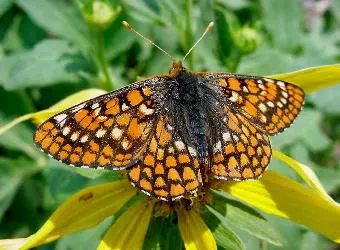SACRAMENTO MOUNTAINS, N.M. — The U.S. Fish and Wildlife Service is inviting public feedback on its newly released draft recovery plan for the Sacramento Mountains checkerspot butterfly, a species found only in high-altitude meadows of south-central New Mexico.
Listed as endangered in 2023, the butterfly faces multiple threats, including wildfires, climate variability, incompatible grazing, invasive plants, and recreational activity. The species depends on a narrow range of habitat conditions and specific plants — including New Mexico penstemon as a host and orange sneezeweed for nectar.
The draft plan outlines a long-term strategy to stabilize and grow the butterfly’s population. Key efforts include:
- Fenced exclosures in Lincoln National Forest to protect habitat from overgrazing.
- Habitat restoration to increase nectar sources and host plants.
- Captive breeding, led by the Albuquerque BioPark, which began raising the butterflies in 2022.
- Advanced reproduction techniques to support population recovery.
Recovery is expected to take three decades due to several biological and environmental challenges:
- The butterfly currently exists in only two meadows, with a population of just 13 individuals.
- It has one generation per year, and up to 98% of individuals die before reaching adulthood.
- The species is highly sensitive to climate shifts, including drought and changing monsoon patterns, which affect plant availability and survival.
- Restoration efforts require time to rebuild habitat, increase plant diversity, and establish stable breeding populations.
- The butterfly has low genetic diversity and limited ability to move between habitats, making long-term planning essential for resilience.
The estimated cost of the recovery plan is $2.35 million.
The 30-day public comment period is now open and will close on October 23, 2025. To review the draft plan and submit comments, visit: https://ecos.fws.gov/ecp/species/1546









